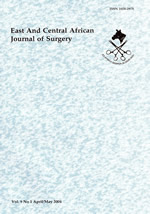
|
East and Central African Journal of Surgery
Association of Surgeons of East Africa and College of Surgeons of East Central and Southern Africa
ISSN: 1024-297X
EISSN: 1024-297X
Vol. 16, No. 3, 2011, pp. 94-101
|
 Bioline Code: js11057
Bioline Code: js11057
Full paper language: English
Document type: Research Article
Document available free of charge
|
|
|
East and Central African Journal of Surgery, Vol. 16, No. 3, 2011, pp. 94-101
| en |
Vascular Lesions Seen among Patients Treated at Muhimbili National Hospital in Dar es Salaam, Tanzania
Moshy, J.; Owibingire, S. & Shaban, S.
Abstract
Background:
Birthmarks sometimes represent significant vascular anomalies that require diagnosis and treatment. This study was aimed at determining the demographic and clinical pattern of vascular lesions seen among patients attending The Oral and Maxillofacial Surgical Clinic at Muhimbili National Hospital.
Methods:
A cross-sectional descriptive study was done at Muhimbili National Hospital between 2008 and 2011. The study population consisted of patients attending the Oral and Maxillofacial Surgical unit with histologically/cytologically confirmed vascular lesions. Clinical and demographic data of these patients were recorded and analyzed.
Results:
Study consisted of 33 patients. The male to female sex ratio was 1: 1.1. The ages ranged from 1 month to 56 years with a mean of 9.4 years. The age group 0-9 years was the most commonly affected. Haemangioma was the commonest vascular lesion found in 19(57.6%) followed by lymphangioma in 12(36.4%). Cystic hygroma and syndromic vascular lesions were found less frequently. Females were slightly more affected with haemangioma compared to males while lymphangioma affected both sexes equally. Most haemangiomas 14(73.7%) presented after birth while most lymphangiomas 9(75%) presented at birth. The cheek and upper lip were the commonest sites affected in 11(33.3%) and 10(30.3%) respectively. The commonest location for haemangiomas were the cheek 7(21.2) and upper lip 5(15.2%). Lymphangiomas were commonly located on the upper lip 5(15.2%) followed by the cheek 4(12.1%).
Conclusion:
The Findings in our review concurred with previous studies on vascular lesions but differed on fact that haemangiomas were the commonest vascular lesion in the head and neck area instead of lymphangioma. This calls for a large multicentre study to confirm this finding.
|
| |
© Copyright 2011 - East and Central African Journal of Surgery
|
|
